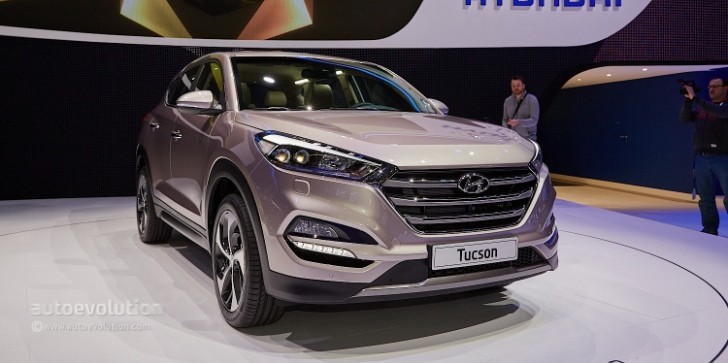The fact that Hyundai has shown its all-new Tucson compact SUV in Geneva is not a surprise. However, it was only during the first press day that an amazing pair of eco powertrains were revealed.
The first is the Tucson 48V Hybrid which is powered by a combination of 136 PS 2-liter turbodiesel matched to a six-speed manual and a 14 PS electric motor. The setup is simple, similar to what Kia showed with its Optima T-Hybrid last year. The combined output is rated at 150 PS and 413 Nm of torque. The model emits 109 grams of CO2 per kilometer, which is respectable, but not in the same league as a Prius.
The major advantage of the drivetrain is that it's relatively simple and only adds 20 kilos (44 lbs). The hybrid drive packs the usual hybrid starter generator, an inverter and a low-voltage DC/DC converter. But the big surprise is that the lithium-ion battery pack is a 48V unit, like what Audi said it was going to use in the future.
The 2016 Tucson will also have a plug-in hybrid system, though it's being previewed as a concept for now. It combines a 115 PS 1.7-liter CRDi diesel and a 7-speed DCT for the front wheels, with an 68 HP electric motor for the back axle. Total output is said to be 183 PS and 473 Nm.
The 10.7 kWh battery pack gives it a total EV range of 50 kilometers (32 miles), identical to the Audi A3 e-tron. Emissions of 48 g/km are also among the lowest of any PHEV.
As far as the regular engine lineup is concerned, the 2016 Tucson will pack a 1.6-liter GDI, followed by a 176 PS turbo version of that mill fitted with a 7-speed dual-clutch gearbox. Diesel options include a 1.7-liter CRDi with 115 PS and a 2-liter available in two stages: 136 PS and 184 PS, both available with a 6-speed automatic.
From the front, it looks a lot more like a car or a sports SUV (think BMW X4). The wheel arches are forward-angled, while the headlights are narrower and connect to a large chrome grille. While the back is just as sexy, the wide-opening hatch still provides access to an ample 513-liter trunk with the rear seats in place.
Inside, the first thing you notice is that all the surfaces are premium. Even though the cabin isn't that much bigger, there's more space because the front seats have been scolloped to give better legroom in the rear. The doors open wider, facilitating access.
The driving position is lower than before and Hyundai officials told us an N-Line body kit will be made available.
The major advantage of the drivetrain is that it's relatively simple and only adds 20 kilos (44 lbs). The hybrid drive packs the usual hybrid starter generator, an inverter and a low-voltage DC/DC converter. But the big surprise is that the lithium-ion battery pack is a 48V unit, like what Audi said it was going to use in the future.
The 2016 Tucson will also have a plug-in hybrid system, though it's being previewed as a concept for now. It combines a 115 PS 1.7-liter CRDi diesel and a 7-speed DCT for the front wheels, with an 68 HP electric motor for the back axle. Total output is said to be 183 PS and 473 Nm.
The 10.7 kWh battery pack gives it a total EV range of 50 kilometers (32 miles), identical to the Audi A3 e-tron. Emissions of 48 g/km are also among the lowest of any PHEV.
As far as the regular engine lineup is concerned, the 2016 Tucson will pack a 1.6-liter GDI, followed by a 176 PS turbo version of that mill fitted with a 7-speed dual-clutch gearbox. Diesel options include a 1.7-liter CRDi with 115 PS and a 2-liter available in two stages: 136 PS and 184 PS, both available with a 6-speed automatic.
Tucson replaces the ix35 globally
While the ix35 and Tucson were basically the same thing, Hyundai has decided to keep only one name, just like it did with the Santa Fe. This compact SUV model has been designed to be both classier and sportier at the same time and a lot is riding on its success.From the front, it looks a lot more like a car or a sports SUV (think BMW X4). The wheel arches are forward-angled, while the headlights are narrower and connect to a large chrome grille. While the back is just as sexy, the wide-opening hatch still provides access to an ample 513-liter trunk with the rear seats in place.
Inside, the first thing you notice is that all the surfaces are premium. Even though the cabin isn't that much bigger, there's more space because the front seats have been scolloped to give better legroom in the rear. The doors open wider, facilitating access.
The driving position is lower than before and Hyundai officials told us an N-Line body kit will be made available.























